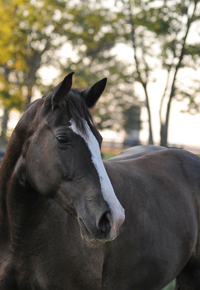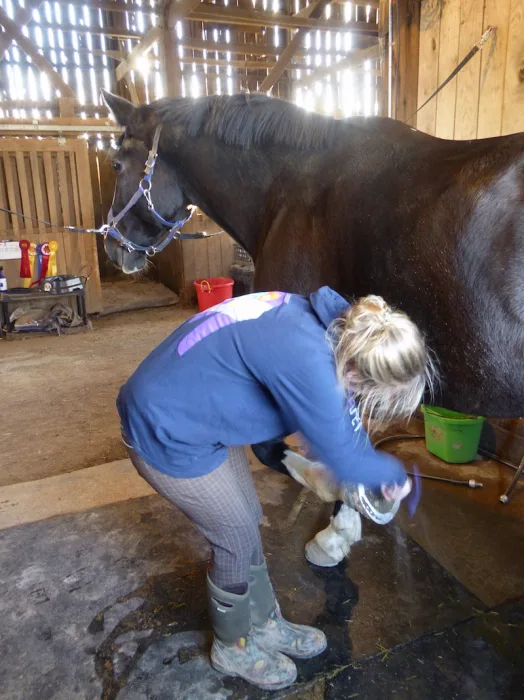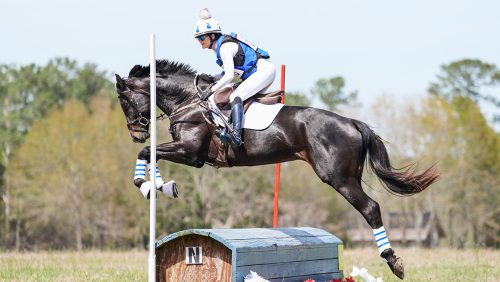I spend a lot of time in my training columns focusing on under saddle work with bipeds and helping them to make the appropriate equipment choices, but several of my fans have pointed out I have skipped over one of the most important activities we do with our humans: grooming.
You may wonder if it’s worthwhile to spend precious energy on something so basic, but consider this—you’ve seen the bits of hay stuck to your human’s fleece, the layers of dust on her breeches (does she ever wash those?) and the questionable hairstyles she comes up with after a ride. Grooming is probably not intuitive for her.
 A lot of this ties in with proper mud application, which starts with understanding the differences between mud types. (If you haven’t made your self familiar with the different types, or need a refresher, I suggest you start there first.)
A lot of this ties in with proper mud application, which starts with understanding the differences between mud types. (If you haven’t made your self familiar with the different types, or need a refresher, I suggest you start there first.)
• Before you begin, make sure you have done a thorough job of mud application.
• Secure the human in a safe location like a wash stall or set of crossties. I prefer wash stalls because they keep the biped out of the way of others and in a contained space. As the grooming process progresses, she will certainly end up with tools littered all around the place. Encourage her to clean up periodically by bumping your ankles into stray buckets, hoses or grooming bags.
• I prefer humans to work front to back, top to bottom. It’s easy enough to correct them if they end up in the wrong spot—simply remove the body part they’re working on and offer them the correct one. This also helps to limber you up before the ride by stretching your neck, moving your shoulders and swinging your hips.
• I find humans often use the wrong tool for the wrong part of the equine body. Sometimes this needs to be corrected, and other times it needs to be encouraged. If the biped uses a curry, hard brush, soft brush, rag, hand or basically anything else on my face, it’s a no go. (Fortunately, it’s not too hard to lift my poll high enough that her stubby arms can’t reach.) When she chooses a softer implement, she’s more likely to leave your carefully-applied dust layer in place. Reserve any shaking (which might scatter dust particles) for when she’s digging around through the grooming bag, so her attention isn’t drawn to this.
ADVERTISEMENT
• Humans must give the proper warning before switching tools or sides of the body. It’s jarring to be standing in the wash stall, contemplating the best way to tackle that rabbit’s nest in the north corner of your paddock, when suddenly someone begins aggressively currying your rump. A skittering of the hind feet (especially if you have shoes) can get the point across by striking fear in her heart as she tries to figure out which direction the feet are moving.
• Teaching the human to properly pick feet is a long process. The most important lesson about the whole thing for bipeds is developing a sense of patience as they wait for a hoof to be lifted. You don’t want them to take this process for granted—after all, it requires balance and core strength on your part.
Bipeds tend to ask for a foot lift by squeezing the tendons on the back of the equine leg. Not only is this rude, but it also demonstrates a complete misunderstanding. I deal with swarms of flies in the summer—a little poke-poke on my leg is the least of my worries.
When this doesn’t work, they’ll often lean a shoulder into mine. Some quadruped instructors make the mistake of pushing back against the person, which convinces them the process is a back-and-forth battle. It’s much better to exactly match their force, so they exhaust themselves while feeling they’re standing still. Sooner or later, this will create learned helplessness, and they’ll ask a little more nicely.
• My human often finishes a grooming session with some kind of dreadful conditioning spray. Sometimes these smell good, and sometimes they reek. The donkey in the neighboring paddock to mine periodically develops some sort of odd cough, which I think is a reaction to the fruitier of these sprays. I try to inform the human of the strength of these liquids by swishing my tail, creating a breeze that will blow it back in her face when she switches sides. And if the detangling aspect happens to work on her hair, that’s not a bad thing, either.
 |
Jitterbug is a Michigan-bred Professional Draft Cross who skillfully avoided saddles until age 5. Since then, she has been lauded for her talent in successfully managing humans while training herself to one day achieve eventing greatness. Jitter and her human live in central Kentucky. Read all of Jitter’s COTH columns. Follow Jitterbug on Facebook! Photo by Dark Horse Photography. |
















